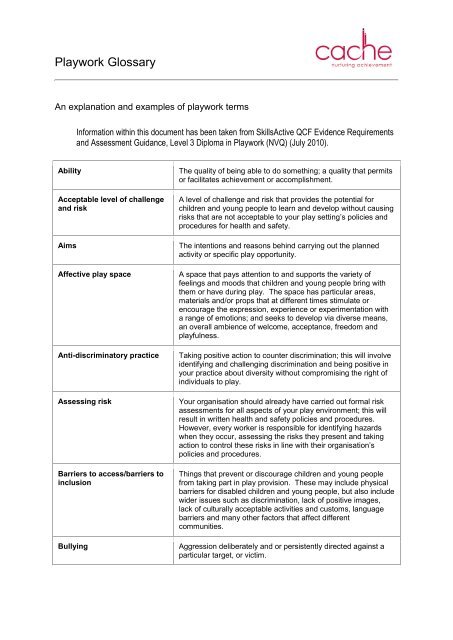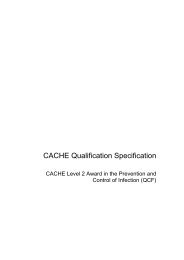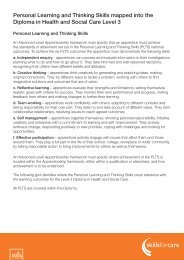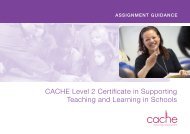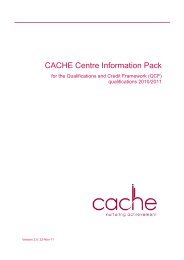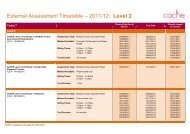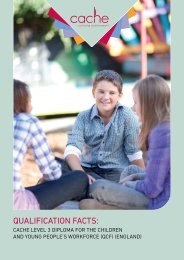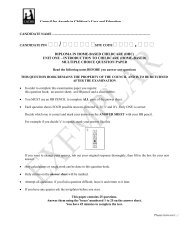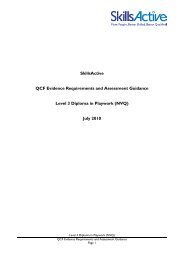Playwork Glossary - Cache
Playwork Glossary - Cache
Playwork Glossary - Cache
Create successful ePaper yourself
Turn your PDF publications into a flip-book with our unique Google optimized e-Paper software.
<strong>Playwork</strong> <strong>Glossary</strong><br />
An explanation and examples of playwork terms<br />
Information within this document has been taken from SkillsActive QCF Evidence Requirements<br />
and Assessment Guidance, Level 3 Diploma in <strong>Playwork</strong> (NVQ) (July 2010).<br />
Ability<br />
Acceptable level of challenge<br />
and risk<br />
Aims<br />
Affective play space<br />
Anti-discriminatory practice<br />
Assessing risk<br />
Barriers to access/barriers to<br />
inclusion<br />
Bullying<br />
The quality of being able to do something; a quality that permits<br />
or facilitates achievement or accomplishment.<br />
A level of challenge and risk that provides the potential for<br />
children and young people to learn and develop without causing<br />
risks that are not acceptable to your play setting’s policies and<br />
procedures for health and safety.<br />
The intentions and reasons behind carrying out the planned<br />
activity or specific play opportunity.<br />
A space that pays attention to and supports the variety of<br />
feelings and moods that children and young people bring with<br />
them or have during play. The space has particular areas,<br />
materials and/or props that at different times stimulate or<br />
encourage the expression, experience or experimentation with<br />
a range of emotions; and seeks to develop via diverse means,<br />
an overall ambience of welcome, acceptance, freedom and<br />
playfulness.<br />
Taking positive action to counter discrimination; this will involve<br />
identifying and challenging discrimination and being positive in<br />
your practice about diversity without compromising the right of<br />
individuals to play.<br />
Your organisation should already have carried out formal risk<br />
assessments for all aspects of your play environment; this will<br />
result in written health and safety policies and procedures.<br />
However, every worker is responsible for identifying hazards<br />
when they occur, assessing the risks they present and taking<br />
action to control these risks in line with their organisation’s<br />
policies and procedures.<br />
Things that prevent or discourage children and young people<br />
from taking part in play provision. These may include physical<br />
barriers for disabled children and young people, but also include<br />
wider issues such as discrimination, lack of positive images,<br />
lack of culturally acceptable activities and customs, language<br />
barriers and many other factors that affect different<br />
communities.<br />
Aggression deliberately and or persistently directed against a<br />
particular target, or victim.
<strong>Playwork</strong> <strong>Glossary</strong><br />
Children and young people<br />
Children and young people’s<br />
rights<br />
Colleagues<br />
Communicate/communication<br />
Concern<br />
Consult/consultation<br />
Continuing professional<br />
development<br />
Cultural dietary requirements<br />
Development<br />
All children and young people of school age with respect for any<br />
impairment, their gender, race, culture, language, sexuality,<br />
health, economic or social status and any other individual<br />
characteristics.<br />
Children and young people’s entitlements under law and the<br />
United Nations Convention on the Rights of the Child. In<br />
particular that children and young people have a right to play<br />
and free time, and to say what they think and be listened to<br />
about decisions that affect them<br />
The people you work with – people who report to you, people<br />
working at the same level as yourself or your manager(s).<br />
Conveying knowledge, information, feelings, ideas, needs or<br />
wants to others.<br />
The awareness of indicators (verbal or behavioural from the<br />
child/young person or information from third parties) that a<br />
child/young person’s physical or emotional well-being has been<br />
disrupted. Some indicators could result from for example<br />
bereavement, difficulties or transitions at home or school.<br />
Indicators may also suggest the possibility of child abuse or an<br />
abusive situation.<br />
An active two-way process of informing and involving individuals<br />
and groups to encourage the sharing of ideas, views and<br />
opinions especially in order to reach an agreed decision.<br />
An ongoing process to support your individual professional<br />
development; this could involve going on a course, or observing<br />
other members of staff doing things that are new to you,<br />
receiving instructions from other members of staff on new things<br />
you have to do, having the opportunity to practise new skills,<br />
reading playwork theory, relevant research.<br />
The types of food and drinks that children and young people are<br />
allowed or not allowed to consume according to the<br />
requirements of their culture, for example Moslem or Jewish<br />
children not eating pork or Hindu children not eating beef.<br />
This includes play-related aspects of human growth from birth<br />
through adolescence. These include the progressive<br />
development of the child's intellectual skills; personality<br />
development, involving the complex interaction between<br />
psychological and social factors and the stage-by-stage<br />
development of the body and physical skills; it also includes<br />
socialisation, the process by which children and young people<br />
adjust to society and its demands.
<strong>Playwork</strong> <strong>Glossary</strong><br />
Difference<br />
Disability *<br />
The way that one person is different to others for example<br />
because of their appearance, attitudes, behaviour, likes,<br />
dislikes, ways of communicating, ability etc.<br />
The disadvantage or restriction of activity caused by the way<br />
society is organised today, which takes little or no account of<br />
people with impairments, and thus excludes them from taking<br />
part in mainstream social activities. Disability is therefore a<br />
particular form of social oppression and discrimination.<br />
* Definition – based on UN 1981 International Year of Disabled People<br />
Disabled children and young<br />
people<br />
Disabling attitudes/behaviour<br />
Discriminatory<br />
practice/attitudes<br />
Diversity<br />
Effectively<br />
Children and young people with impairments who experience<br />
barriers accessing play facilities. This includes children with<br />
physical and sensory impairments, learning and communication<br />
difficulties, medical conditions, challenging and complex<br />
requirements which may be permanent or temporary.<br />
Practice and attitudes that fail to acknowledge an individual’s<br />
ability to participate in play and exercise freedom of choice.<br />
Practice and attitudes that fail to acknowledge an individual’s<br />
right to participate in play and exercise freedom of choice<br />
Where there is difference and variety that reflects a broad mix of<br />
people from, for example, various demographic, socioeconomic,<br />
ethnic and cultural backgrounds and types of ability<br />
Producing a successful outcome for the persons involved<br />
Emergency<br />
Feedback<br />
A situation requiring an immediate response, ranging from<br />
calling 999 to a problem that requires prompt action by staff<br />
within the play environment<br />
Other people – children, young people or colleagues – telling<br />
you what they think.<br />
Financial transactions<br />
Good team work<br />
The exchange of money for goods/services which could include,<br />
for example: purchasing equipment or services, paying salaries,<br />
collection of fees/subscriptions, insurance premiums, rent etc.<br />
The type of relationship with your colleagues that helps the<br />
team to work well and provide a high level of service to children<br />
and young people. This includes getting along well with your<br />
colleagues, being fair to them, avoiding unnecessary<br />
disagreements and not letting your personal life influence the<br />
way you relate to colleagues.
<strong>Playwork</strong> <strong>Glossary</strong><br />
Group agreements<br />
Hazard<br />
Health and safety policies and<br />
procedures<br />
Health and safety<br />
requirements<br />
Impairment **<br />
Decisions made after discussion with and between children and<br />
young people on how they would like to be treated by/treat<br />
others. These agreements are often made on an ad hoc basis<br />
to fit a particular or spontaneous situation, but can also be<br />
made on an informal or formal basis. They are flexible and exist<br />
to accommodate children and young people’s requirements and<br />
preferences, rather than be rules imposed by adults.<br />
Something that may cause harm to the health, safety and<br />
welfare of users of the play environment, for example, broken<br />
glass, faulty play equipment, doors being left open that should<br />
be closed.<br />
These will be written policies and procedures developed by your<br />
organisation in line with relevant legislation, such as the Health<br />
and Safety at Work Act, the Children Act and Control of<br />
Substances Hazardous to Health regulations.<br />
Those required by law, industry codes of practice, regulatory<br />
authorities, national governing bodies (if relevant), and those of<br />
your own organisation.<br />
Lacking of part or all of a limb, or having a defective limb, organ<br />
or mechanism of the body. An individual physical, psychological<br />
or emotional make-up which differs from accepted ‘norms’.<br />
** Definition – Michael Oliver (1996) Understanding Disability: from theory to<br />
practice<br />
Inclusion/inclusive provision<br />
Individuality<br />
Integrated play provision<br />
Intervention styles<br />
Ensuring that play provision is open and accessible to all and<br />
takes positive action in removing barriers so that all children and<br />
young people, including disabled and non-disabled, and those<br />
from other minority groups, can participate.<br />
The combination of qualities and characteristics that distinguish<br />
one person from others<br />
The intermixing of people previously segregated by impairment<br />
alone. Non-disabled people tend to take the lead regarding the<br />
when, where, how and who.<br />
A range of methods the playworker can use in the play<br />
environment. these may range from complete non-involvement<br />
through to specific intervention and may include: waiting to be<br />
invited to play; enabling un-interrupted play; enabling children<br />
and young people to explore their own values; leaving children<br />
and young people to improve their own performance; leaving<br />
the content/intent of play to the children/young people; letting<br />
the children and young people decide why they play; enabling<br />
the children and young people to decide what is appropriate<br />
behaviour; only organising when children and young people<br />
want you too.
<strong>Playwork</strong> <strong>Glossary</strong><br />
Observation<br />
Organisation<br />
Organisation’s policies and<br />
procedures<br />
Parents and carers<br />
Permanent play space<br />
Physical play space<br />
Plan<br />
Play cues***<br />
The purpose of observation in a play environment is to observe<br />
children and young people’s play behaviours and the response<br />
of adults to ensure the environment continues to provide<br />
effective play spaces. These observations may include play<br />
types, cues and returns and playworkers’ interventions. These<br />
observations are not for the purpose of monitoring children’s<br />
development, planning activities or a curriculum; observations<br />
may or may not be recorded.<br />
In this context an organisation is a separate group to your own<br />
play setting; organisations may include formally or non-formally<br />
constituted groups, young people-formed, led and run<br />
companies, community settings, schools etc.<br />
What your organisation says its staff should and should not do<br />
in certain situations.<br />
All people with parental or caring responsibilities for children,<br />
including primary and non-primary carers. This term should be<br />
taken to include all family members (including brothers and<br />
sisters) who may have caring responsibilities, wider family<br />
members, partners of parents and childminders or similar.<br />
Spaces that are fixed and cannot move, e.g. certain structures,<br />
kitchen etc., but these spaces may still also incorporate<br />
transient play spaces at different times.<br />
Spaces that support children and young people in physically<br />
playing in any way they wish, for example, moving, running,<br />
jumping, climbing, swinging, dancing, wrestling, sliding, chasing,<br />
as well as all the fine motor skills.<br />
Evidence that the specific play opportunity has been<br />
systematically organised; this would usually take some kind of<br />
written or visual format.<br />
Facial expressions, language or body language that<br />
communicates the child or young person’s wish to play or invite<br />
others to play.<br />
*** Gordon Sturrock and Perry Else, 1998, The playground as therapeutic<br />
space: playwork as healing (known as “The Colorado Paper”), published in Play<br />
in a Changing Society: Research, Design, Application, IPA/USA, Little Rock,<br />
USA. Available as a PDF free of charge from www.ludemos.co.uk or<br />
info.ludemos@virgin.net.
<strong>Playwork</strong> <strong>Glossary</strong><br />
Play cycle***<br />
The full flow of play from the first play cue from the child, its<br />
return from the outside world, the child’s response to the return<br />
and the further development of play to the point where play is<br />
complete. The cycle includes the metalude, the cue, the return,<br />
the frame, adulteration, annihilation and display<br />
*** Gordon Sturrock and Perry Else, 1998, The playground as therapeutic<br />
space: playwork as healing (known as “The Colorado Paper”), published in Play<br />
in a Changing Society: Research, Design, Application, IPA/USA, Little Rock,<br />
USA. Available as a PDF free of charge from www.ludemos.co.uk or<br />
info.ludemos@virgin.net.<br />
Play environment<br />
Play process<br />
Play space<br />
<strong>Playwork</strong> practice<br />
Qualitative<br />
Quantitative<br />
Reflect<br />
Anywhere where children and young people play, for example,<br />
parks, open spaces, streets, adventure playgrounds, afterschool<br />
clubs, holiday play schemes or indoor play centres,<br />
whether supervised or unsupervised.<br />
There is much ongoing debate about what The Play Process is<br />
and individuals will continue to discuss and come to their own<br />
conclusions. However, for the purposes of this glossary, in the<br />
simplest terms, the Play Process is what the child goes through<br />
and what they experience and what they feel whilst they are<br />
engaged in playing.<br />
Any area – physical, affective, permanent or transient – that<br />
supports and enriches the potential for children and young<br />
people’s self-directed play. A play environment may consist of<br />
one or any number of play spaces.<br />
What you do in the play environment to implement the <strong>Playwork</strong><br />
Principles, including what you say and don’t say and what you<br />
do and don’t do.<br />
Something that is not summarised in numerical form, such as<br />
minutes from meetings and general notes from observations.<br />
Qualitative data normally describe people's knowledge,<br />
attitudes or behaviours and is often more subjective.<br />
Something measured or measurable by, or concerned with,<br />
quantity and expressed in numbers or quantities.<br />
Thinking about your work and identifying what you do well and<br />
what you could improve in.
<strong>Playwork</strong> <strong>Glossary</strong><br />
Resources<br />
Responsible Colleague<br />
Risk<br />
Security hazards<br />
Segregated play provision<br />
Security hazards<br />
Self-powered<br />
Separate play provision<br />
Equipment and materials that will stimulate play: natural<br />
materials (such as earth, water, sand, clay or wood);<br />
construction materials (such as blocks); computer and IT<br />
equipment; communication resources (resources to support<br />
speaking, listening, reading and writing); ‘loose parts’ ( items<br />
that can be moved from place to place, carried, rolled, lifted,<br />
piled one on top of the other or combined to create new<br />
structures or experiences); real tools (such as carpentry or<br />
cooking equipment); bikes, trolleys, swings, climbing structures<br />
and ropes; paints, drawing equipment, modelling and fabrics;<br />
music, colours, scientific and mathematical equipment (such as<br />
clocks and calendars); dressing up materials, mirrors, cameras,<br />
videos to enable children to explore their own identity; items or<br />
experiences (such as poetry and literature) that allow for<br />
reflection about abstract concepts.<br />
The colleague with overall responsibility for the play<br />
environment on a specific play opportunities basis i.e. – the<br />
person in charge of the group you are working with.<br />
The possibility of a hazard actually causing harm – and the<br />
seriousness of harm it may cause – to children, young people<br />
and others, this will often be influenced by the level of<br />
understanding and development of the children and young<br />
people involved.<br />
For example strangers, familiar adults with access restrictions,<br />
opportunities for younger children to leave a supervised setting,<br />
suspect packages etc.<br />
The setting aside of disabled children and young people, based<br />
on a professional’s view of impairment and lack of ability to ‘fit<br />
in’. Non-disabled professionals have total control.<br />
For example strangers, familiar adults with access restrictions,<br />
opportunities for younger children to leave a supervised setting,<br />
suspect packages etc.<br />
For example, on foot or by bicycle or canoe<br />
Groups of disabled children and young people who choose to<br />
meet and develop their own agenda, similar to other minority<br />
groups.<br />
Serious injury<br />
Social Model of Disability<br />
An injury that is life threatening or may result in permanent<br />
impairment.<br />
The social model identifies that society is a disabling factor<br />
when lack of physical, environmental and attitudinal access<br />
excludes disabled people from everyday life.
<strong>Playwork</strong> <strong>Glossary</strong><br />
Specific dietary requirements<br />
Support<br />
Transient play space<br />
Transition<br />
Unacceptable risk<br />
Requirements that correspond to personal beliefs or particular<br />
medical condition, for example not eating meat, or not eating<br />
nuts or flour-based products.<br />
A process by which the playworker might encourage, help,<br />
inspire, motivate or advocate for children and young people<br />
without directing, controlling or instructing children and young<br />
people.<br />
Spaces that change or get modified, adapted or deconstructed<br />
using a wide range of movable resources, props, materials and<br />
structures – breaking up the wider physical space into different<br />
smaller spaces for different kinds of play at different<br />
times; examples may include: creating dens and hidey-holes;<br />
using fabrics and loose parts to create imaginative places like a<br />
hospital or a forest; shifting furniture back or around to<br />
accommodate particular games; a transient play space could<br />
be the couple of cubic feet behind a piece of furniture, a whole<br />
room or field; it could be created spontaneously or planned<br />
beforehand.<br />
Most children and young people naturally pass through a<br />
number of physical and emotional stages as they grow and<br />
develop. Often, they will also be expected to cope with changes<br />
such as movement from primary to secondary school and for<br />
disabled children or children with chronic ill health, there may be<br />
an additional change of support moving from children’s to adult<br />
services. Such changes are commonly referred to as<br />
transitions. Some children may have to face very particular and<br />
personal transitions not necessarily shared or understood by all<br />
their peers. These include: family illness or the death of a close<br />
relative; divorce and family break-up; issues related to sexuality;<br />
adoption; the process of asylum; disability; parental mental<br />
health; and the consequences of crime.<br />
When a child or young person engages in play behaviour that is<br />
likely to result in death or serious injury. Other risks, whilst<br />
being perceived as dangerous and potentially harmful, can be<br />
considered acceptable because the benefits of the play<br />
experience outweigh the harm that may occur.


